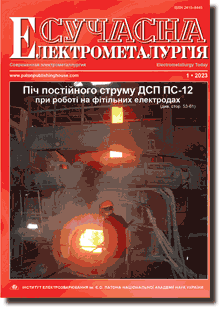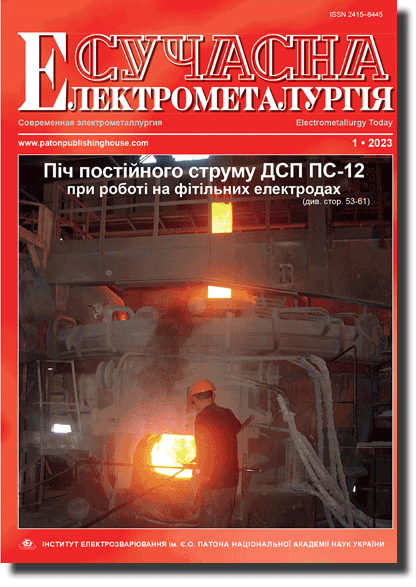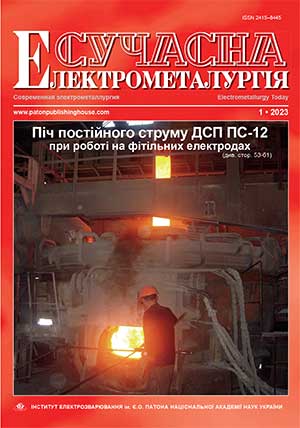| 2023 №01 (03) |
DOI of Article 10.37434/sem2023.01.04 |
2023 №01 (05) |

"Suchasna Elektrometallurgiya" (Electrometallurgy Today), 2023, #1, 25-32 pages
Structure and properties of ingots produced from sheet cuttings of VT-1 titanium by electroslag remelting in an open mould
D.I. Bilonyk1, O.Ye. Kapustyan1, I.A. Ovchynnykova2, I.M. Bilonyk1, G.M. Lapteva1
1National University «Zaporizka politekhnika». 64 Zhukovskogo Str., 69063, Zaporizhzhya, Ukraine. E-mail: aek@zntu.edu.ua2Zaporizhzhya National University. 66 Zhukovskogo Str., 69600, Zaporizhzhya, Ukraine.
Abstract
Analysis of technologies, allowing titanium wastes to be used in the melting process in ingot production, was performed. It is shown that for this purpose a promising and cost-effective schematic is the one which includes electroslag remelting with preliminary manufacture of a consumable electrode completely from standard wastes of sheet cuttings of VT1-0 titanium. The structure and properties of electroslag ingots of titanium of 90×90 mm cross-section and 85 mm diameter was studied. The ingots were produced with application of electroslag remelting in an open mould with sliding current conduit and the slag pool surface protection by argon. Chemical composition of electroslag ingots of unalloyed titanium practically does not differ from that of titanium of VT1-2, VT1-L grades, and a whole range of grades of unalloyed titanium from foreign manufacturers, except for a somewhat higher content of oxygen and nitrogen. Ultrasonic testing of the ingots did not reveal any internal defects. Macrostructure, which was studied on longitudinal and transverse templates, is coarse-crystalline, dense, and homogeneous without any defects of technological origin. The angle of inclination of the columnar crystallites to the ingot axis is 40…45°, grain size is 1.8…2.5 mm. The microstructure consists of transformed β-grains of 140…175 μm size. After annealing (620 °С) the mechanical properties of electroslag ingots were as follows: НВ = 224; σt = 590 MPa; σ0.2 = 560 MPa; δ = 7.5 %; ψ = 13.5 %. Technical measures were determined to improve the ductility of electroslag titanium by reducing the content of oxygen and nitrogen in the ingots, and refining the cast grain size. Technological properties of electroslag titanium (cuttability and weldability) are on the level of VT1-L. The possibility of pressure treatment (hot forging) was established with deformation coefficients of 40 and 90 % of titanium from electroslag ingots. The obtained semi-finished products did not have any internal or surface defects. Ref. 24, Tabl. 2, Fig. 8.
Keywords: processing; sheet cuttings; titanium; electron beam meting; electroslag process; ingot; structure; chemical composition; mechanical properties; technological properties; hot forging
Received 6.12.2022
References
1. Kolobov, G.A. (2013) Recycling of titanium and titanium alloy wastes. Novi Materialy i Tehnologii v Metalurgii ta Mashynobuduvanni, 1, 138-140 [in Russian].2. Garmata, V.A., Petrunko, A.N., Galitsky, N.V., Olesov, Yu.V. (1983) Titanium: Properties, raw materials, physical and chemical bases and methods for the preparation. Moscow, Metallurgiya [in Russian].
3. https://www.retechsystemsllc.com
4. https://www.ald-vt.com
5. Paton, B.E., Akhonin, S.V., Berezos, V.A. (2018) Development of technologies of electron beam melting of metals at the E.O. Paton Welding Institute of the NAS of Ukraine. Sovrem. Elektrometal., 4, 19-35 [in Russian]. https://doi.org/10.15407/sem2018.04.01
6. Akhonin, S.V., Kruglenko, M.P., Kostenko, V.I. (2010) Removal of refractory inclusions from titanium in electron beam melting by the precipitation mechanism. Advances in Electrometallurgy, 4, 232-236.
7. Paton, B.E., Trigub, N.P., Akhonin, S.V., Zhuk, G.V. (2006) Electron beam melting of titanium. Kyiv, Naukova Dumka [in Ukrainian].
8. Paton, B.E., Trigub, N.P., Akhonin, S.V. (2008) Electron beam melting of refractory and high-reactive metals. Kyiv, Naukova Dumka [in Russian].
9. Kalinyuk, A.N., Derecha, O.Ya., Telin, V.V. et al. (2018) Peculiarities of production of slab-type cast billets of VT1-0 and GRADE 2 types of low-grade spongy titanium. Sovrem. Elektrometal., 3, 20-26 [in Russian]. https://doi.org/10.15407/sem2018.03.03
10. Ryabtsev, A.D., Troyansky, A.A. (2001) Production of ingots of titanium, chromium and alloys on their base in chamber electroslag furnaces using "active" metal containing fluxes. Problemy Spets. Elektrometallurgii, 4, 6-9 [in Russian].
11. Protokovilov, I.V., Nazarchuk, A.T., Petrov, D.A., Porokhonko, V.B. (2018) Technological and metallurgical peculiarities of melting the titanium alloy ingots in chamber-type electroslag furnaces. Sovrem. Elektrometal., 2, 45-50 [in Russian]. https://doi.org/10.15407/sem2018.02.06
12. Bilonik, D.I., Ovchynnykov, O.V., Bilonik, I.M. et al. (2022) Electroslag melting in an open mould of ingots from sheet scrap wastes of titanium VT1-0. Suchasna Elektrometal., 1, 34-39 [in Ukrainian]. https://doi.org/10.37434/sem2022.01.04
13. Bogomolova, N.A. (1978) Practical metallography. Moscow, Vysshaya Shkola [in Russian].
14. (2019) DSTU ISO 6892-1:2019. Metallic materials. Tensile testing. Pt 1. Method of test at room temperature [in Ukrainian].
15. (1967) GOST 6996-66. Welded joints. Methods of determination of mechanical properties [in Russian].
16. Bibikov, E.L., Glazunov, S.G., Neustruyev, A.A. et al. (1983) Titanium alloys. Production of shaped castings from titanium alloys. Moscow, Metallurgiya [in Russian].
17. Ovchynnykov, O.V., Kapustian, O.E. (2020) Technology for smelting zirconium alloy ingots by vacuum arc remelting with a non-consumable electrode in a skull furnace. Suchasna Elektrometal., 4 , 32-38 [in Ukrainian]. https://doi.org/10.37434/sem2020.04.06
18. Dreval, A.E., Skorokhodov, E.A., Ageev, A.V. (2005) Guick reference guide of metalworker. Moscow, Mashinostroenie [in Russian].
19. Glazunov, S.G., Vazhenin, S.F., Zyukov-Batyrev, G.L., Ratner, Ya.L. (1975) Application of titanium in national economy. Kyiv, Tekhnika [in Russian].
20. Paton, B.E. (1974) Technology of fusion electric welding of metals and alloys. Moscow, Mashinostroenie [in Russian].
21. Nikolsky, L.A., Figlin, S.Z., Bojtsev, V.V. (1975) Hot stamping and pressing of titanium alloys. Moscow, Mashinostroenie [in Russian].
22. Samsonov, G.V., Kashchuk, V.A., Cherkashin, A.I. (1970) Effect of transition metals on the grain size of titanium. Metallovedenie i Termich. Obrabotka Metallov, 11, 30-32 [in Russian]. https://doi.org/10.1007/BF00653388
23. Grigorenko, G.M., Akhonin, S.V., Loboda, P.I. et al. (2016) Structure and properties of titanium alloy doped with boron, produced by the method of electron beam remelting. Sovrem. Elektrometal., 1, 21-25 [in Russian]. https://doi.org/10.15407/sem2016.01.03
24. Goltvyanchuk, V.S., Bankovskyi, O.B., Tsyvirko, E.I. (2009) Modifying titanium-aluminium cast alloys by boron. Novi Materialy i Tehnologii v Metalurgii ta Mashynobuduvanni, 1, 86-88 [in Ukrainian].
Advertising in this issue:
The cost of subscription/purchase order journals or individual articles
| Journal/Currency | Annual Set | 1 issue printed |
1 issue |
one article |
| TPWJ/USD | 384 $ | 32 $ | 26 $ | 13 $ |
| TPWJ/EUR | 348 € | 29 € | 24 € | 12 € |
| TPWJ/UAH | 7200 UAH | 600 UAH | 600 UAH | 280 UAH |
| AS/UAH | 1800 UAH | 300 UAH | 300 UAH | 150 UAH |
| AS/USD | 192 $ | 32 $ | 26 $ | 13 $ |
| AS/EUR | 180 € | 30 € | 25 € | 12 € |
| SEM/UAH | 1200 UAH | 300 UAH | 300 UAH | 150 UAH |
| SEM/USD | 128 $ | 32 $ | 26 $ | 13 $ |
| SEM/EUR | 120 € | 30 € | 25 € | 12 € |
| TDNK/UAH | 1200 UAH | 300 UAH | 300 UAH | 150 UAH |
| TDNK/USD | 128 $ | 32 $ | 26 $ | 13 $ |
| TDNK/EUR | 120 € | 30 € | 25 € | 15 € |
AS = «Automatic Welding» - 6 issues per year;
TPWJ = «PATON WELDING JOURNAL» - 12 issues per year;
SEM = «Electrometallurgy Today» - 4 issues per year;
TDNK = «Technical Diagnostics and Non-Destructive Testing» - 4 issues per year.









